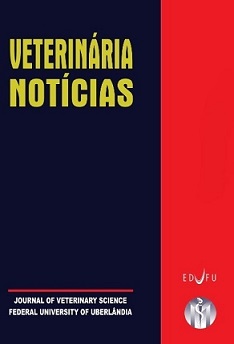Extruded feed in different volume-concentrate ratios: in-vitro fermentation kinetics, consumption, and evaluation of lambs’ metabolic profile
DOI:
https://doi.org/10.14393/VTN-v26n2-2020-46321Abstract
This study aimed both to evaluate the metabolic profile of lambs
fed with extruded forage and concentrate containing different roughageconcentrate ratios (R:C) and to evaluate in-vitro ruminal fermentation
kinetics of these rations. An experiment was carried out with 20 weanling,
female crossbred lambs (½Dorper x ½Santa Inês) aged 120 ± 8 days. The
treatments were four R:C ratios of extruded forage (Foragge®) and extruded
concentrate (Beef Total®) – 30%F:70%C, 40%F:60%C, 50%F:50%C, and
60%F:40%C – distributed randomly with five replicates. The analysis
targeted energy metabolites (VLDL, triglycerides, and cholesterol), hepatic
metabolites (alkaline phosphatase, gamma glutamyltransferase [GGT], and
aspartate aminotransferase [AST]), and protein metabolites (total protein,
uric acid, urea, creatinine, albumin, and globulin). In-vitro gas production
was quantified by inoculating the extruded rations in bovine ruminal fluid
with the following forage:concentrate proportions evaluated: 30%F:70%C,
40%F:60%C, 50%F:50%C, 60%F:40%C and 70%F:30%C. Fermentation
kinetic values were compared using parallelism test and curve identity at
the error probability level of 5%. A regression study was used to compare the
means of the metabolites at the error probability level of 5%. Average dry
matter intake data are provided descriptively. The extruded ration
increased the hepatic metabolites (GGT and AST) without compromising the
liver and kept the energy metabolites stable. Similarly, the serum
concentration of protein metabolites remained at normal levels
recommended to the ovine species. In-vitro fermentation pattern displayed
high gas production associated with high ration digestibility. The extruded
ration provides protein and energy supply to meet the animals’ nutritional
requirements without compromising their health.

